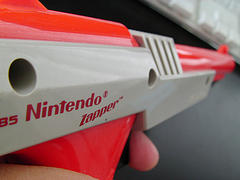
How’d they do that? The Wikipedia explanation hurts my brain.
When the trigger was pulled, the game blanked out the screen with a black background for one frame, then, for one additional frame, drew a solid white rectangle around the sprite the user was supposed to be shooting at. The photodiode at the back of the Zapper would detect these changes in intensity and send a signal to the NES to indicate whether it was over a lit pixel or not. A drop followed by a spike in intensity signaled a hit. Multiple sprites were supported by flashing a solid white rectangle around each potential sprite, one per frame.
It is possible to cheat in games by changing the brightness and contrast of the television, or pointing the gun at a bright light. The gun thinks it is pointing at a solid white target and will report a hit. If there are multiple targets, the “hit” target will be the first to be lit with the white square. This is not as consistent with a fluorescent lamp due to the possible differences in timing of the lamp’s flicker verses the timing of the television’s refresh rate.
Additionally, by using a magnifying glass on the gun, it fools the receptor into thinking that the rectangle is much larger than it actually is, allowing for a shotgun-like effect that will cover the entire screen. The same effect can be achieved by smearing grease to the lens.
Due to the Zapper’s technological limitations, it is not compatible with some HDTVs. The video processing built into a HDTV (scaling, upconverting) can cause a time delay of several frames with the picture output by the console so that even well-aimed shots, which would register as “true” on standard televisions, almost always fail as a result of this time latency.